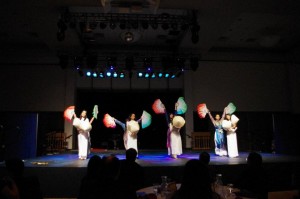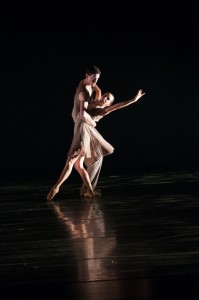
BYU Contemporary Dance Theater will perform in the National Center for Performing Arts for the first time in Beijing this November, bringing Western dance closer to Eastern traditional dance.
Western and Eastern dance styles have developed their own techniques and movements, though neither of them really influence each other.
Heidi Jorgensen, a dance major from O’Fallon, Ill., said Eastern dance is really “culture-based,” and each dance is designed to express one aspect of Eastern culture. Meanwhile, Western dance has adopted a lot of characteristics of different cultures from all over the world. Eastern and Western dancers are also taught to approach dance differently.
“Eastern dancers don’t have opportunities to improvise and choreograph themselves, while Western dancers have the aspect of creativity. They have aspiration of what their bodies can do,” Jorgensen said. “Because Eastern dancers focus so hard on one area, they are extremely good at one genre of dance.”
Jorgensen, who went to China for six weeks to learn about Chinese traditional dances, added that Eastern dance is really detail-oriented. Dancers are required to focus on the movements of their eyes and their fingers. With the heavy emphasis on gestures and facial expressions, a movement can indicate a whole range of emotions.

Van Nguyen, a dancer from Vietnam, said Eastern traditional dance reflects the relationship between dance and culture, whereas Western dance focuses on expressing actions.
“You can see the tie between tradition and dance through the Vietnamese harvest dance, whose purpose is to ask the god for agricultural benefits,” Nguyen said. “Thus the strength of Eastern dance is its reflection of the world. The traditions of Eastern countries come across to audiences more easily.”
Nguyen has been dancing for 10 years and has participated in three different performing groups in Vietnam. In her experiences, Nguyen thinks Western dance attracts audiences with its expressive and active dance moves. On the other hand, Western dances are more descriptive and dramatic because dancers express their personal views in relation to the world.
Julianne Horsley, a BYU graduate from North Salt Lake, pointed out that the main difference between Eastern and Western dance is their intended purpose.
“Asian dances are full of symbolism even with simple movements,” Horsley said. “The costumes, props and music are meant to tell stories. While Western dances are more for enjoyment and entertainment. Some deal with stories but mostly for fun.”
The Eastern and Western cultures are brought closer together through the performance of BYU Contemporary Dance Theater in China this November. As the the Western performing groups have come to the East, the boundary between Eastern and Western dance is slowly disappearing, which may pose a question of cultural identity.




